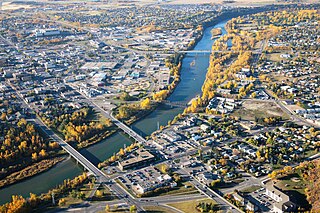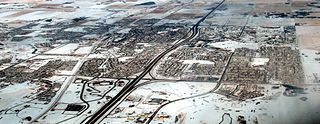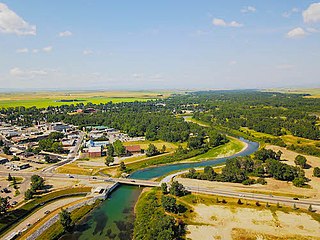
Red Deer is a city in Alberta, Canada, located midway on the Calgary–Edmonton Corridor. Red Deer serves central Alberta, and its key industries include health care, retail trade, construction, oil and gas, hospitality, manufacturing and education. It is surrounded by Red Deer County and borders on Lacombe County. The city is in aspen parkland, a region of rolling hills, alongside the Red Deer River.

Leduc is a city in the province of Alberta, Canada. It is 33 km (21 mi) south of the provincial capital of Edmonton and is part of the Edmonton Metropolitan Region.

Drumheller is a town on the Red Deer River in the badlands of east-central Alberta, Canada. It is located 110 kilometres (68 mi) northeast of Calgary and 97 kilometres (60 mi) south of Stettler. The Drumheller portion of the Red Deer River valley, often referred to as Dinosaur Valley, has an approximate width of 2 kilometres (1.2 mi) and an approximate length of 28 kilometres (17 mi).

Cochrane is a town in the Calgary Metropolitan Region of Alberta, Canada. The town is located 18 km (11 mi) west of the Calgary city limits along Highway 1A. Cochrane is one of the fastest-growing communities in Canada, and with a population of 32,199 in 2021, it is one of the largest towns in Alberta. It is part of Calgary's census metropolitan area and a member community of the Calgary Metropolitan Region Board (CMRB). The town is surrounded by Rocky View County.

Airdrie is a city in Alberta, Canada, within the Calgary Region. It is located north of Calgary within the Calgary–Edmonton Corridor at the intersection of Queen Elizabeth II Highway and Highway 567.
Frank is an urban community in the Rocky Mountains within the Municipality of Crowsnest Pass in southwest Alberta, Canada. It was formerly incorporated as a village prior to 1979 when it amalgamated with four other municipalities to form Crowsnest Pass.

Bowness is a neighbourhood and former town in west Calgary, Alberta, Canada. The former town was amalgamated into the City of Calgary in 1964.

Stony Plain is a town in the Edmonton Metropolitan Region of Alberta, Canada that is surrounded by Parkland County. It is west of Edmonton adjacent to the City of Spruce Grove and sits on Treaty 6 land.

Lacombe is a city in central Alberta, Canada. It is located approximately 25 kilometres (16 mi) north of Red Deer, the nearest major city, and 125 kilometres (78 mi) south of Edmonton, the nearest metropolitan area. The city is set in the rolling parkland of central Alberta, between the Rocky Mountains foothills to the west and the flatter Alberta prairie to the east.

High River is a town within the Calgary Metropolitan Region of Alberta, Canada. It is approximately 68 kilometres (42 mi) south of Calgary, at the junction of Alberta Highways 2 and 23. High River had a population of 14,324 in 2021.

Coleman is a community in the Rocky Mountains within the Municipality of Crowsnest Pass in southwest Alberta, Canada. It was formerly incorporated as a town prior to 1979 when it amalgamated with four other municipalities to form Crowsnest Pass.

Bellevue is an urban community perched 4,280 feet elevation in the Rocky Mountains within the Municipality of Crowsnest Pass in southwest Alberta, Canada. It was formerly incorporated as a village prior to 1979 when it amalgamated with four other municipalities to form Crowsnest Pass.
Jasper Place, originally named West Jasper Place, is a former town in Alberta, Canada now within the City of Edmonton. Prior to amalgamation with Edmonton, the town was bounded by 149 Street to the east, 118 Avenue to the north, 170 Street to the west and the North Saskatchewan River to the south. Its former municipal centre, which included its town hall, fire station and extant Butler Memorial Park, was located at Stony Plain Road and 157 Street. It was known as West Jasper Place from 1910 to 1950.
Kuban, Ron (2005). Edmonton's Urban Villages: The Community League Movement. University of Alberta Press. ISBN 9781459303249.
Rundle Heights is a residential neighbourhood overlooking the North Saskatchewan River valley in the City of Edmonton, Alberta, Canada, named for Methodist missionary Robert Terrill Rundle. While the neighbourhood didn't develop until the 1960s and 1970s, the area is closely associated with the Town of Beverly, a working class community that amalgamated with Edmonton in 1961. A number of the Beverly coal mines were located in the area.
Bergman is a neighbourhood in east Edmonton, Alberta, Canada located immediately to the north of the Town of Beverly townsite. The neighbourhood is named for Gustav C. Bergman who was elected mayor of Beverly in the first municipal election after Beverly incorporated as a town in 1914.
Abbottsfield is a neighbourhood in east Edmonton, Alberta, Canada overlooking the North Saskatchewan River valley. The neighbourhood is named for Abraham Abbott, a resident of the Town of Beverly and long time school custodian in the Beverly School District. While development of Abbottsfield didn't begin until nearly a decade after the amalgamation of Beverly with Edmonton in 1961, the neighbourhood is located in an area closely associated with Beverly. Beverly was a coal mining town, and one of the major Beverly coal mines was located in the Abbottsfield area.
Beacon Heights is a residential neighbourhood in Edmonton, Alberta, Canada that was part of the Town of Beverly before Beverly amalgamated with Edmonton in 1961.
According to the 2021 census, the City of Edmonton had a population of 1,010,899 residents, compared to 4,262,635 for all of Alberta, Canada. The total population of the Edmonton census metropolitan area (CMA) was 1,418,118, making it the sixth-largest CMA in Canada.











